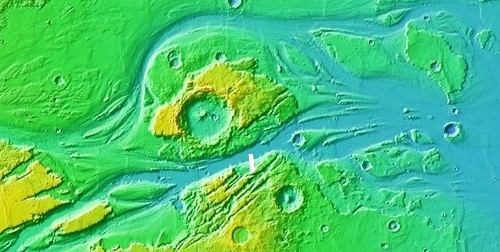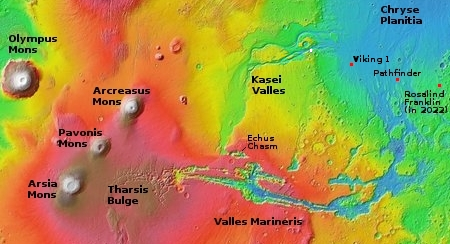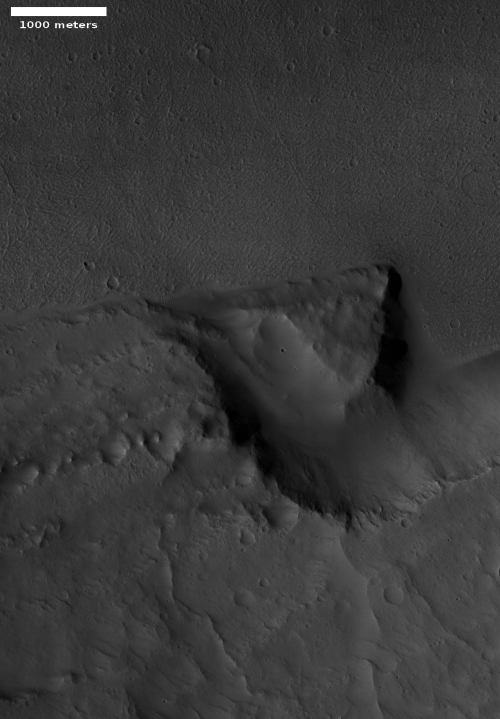Catastrophes on Mars and Earth
Cool image time! The photo to the right, rotated, cropped, and reduced to post here, was taken by the high resolution camera on Mars Reconnaissance Orbiter (MRO) on May 13, 2020, and shows what appears to be a giant block that at some point was attached to the cliff, and then broke off and fell away to the north. Subsequent erosion over the later eons widened the break until it now looks like a canyon.
Sounds great, but the event that separated this big piece of mountain, almost a mile across, from its cliffside was possibly even more catastrophic. And it might not have involved a sudden break and fall, but something more spectacular, and also still impossible based on everything we know about Mars.
Uncovering what really happened at this spot on Mars will not only help us understand the geological history of the Red Planet, it could also amazingly enough help illustrate the cultural shifts going on right now on Earth, and how to shift them in a more rational and sane direction.
This image is located near the outlet of Kasei Valles, one of the larger valleys draining downward from the Tharsis Bulge where Mars’ giant volcanoes are located. The overview map below shows us what Kasei Valles looks like in this area.

The white rectangle indicates the image’s location. From the flow patterns, it sure looks like at one point liquid rushed past this broken block, moving fast from the west to the east. In fact, these flow patterns have been one of the main pieces of evidence that caused planetary scientists to theorize catastrophic floods on Mars, rushing down suddenly from the high country into the low northern plains.

The wider overview map to the right gives use even better context. Once again the white box near the outlet of Kasei Valles, now tiny, indicates this image’s location. Like the bigger canyon Valles Marineris to the south, Kasei Valles provides a major drainage basin to the high volcanoes to the south and west. This wide view suggests that the heat of those volcanoes might have suddenly liquefied underground water, which was then suddenly released eastward, pouring down the canyons and out into the northern plains..

More recent research [pdf] has strengthened these theories. Some scientists now theorize that an ice dam upstream from this location had once existed, as shown on the right from a figure taken from their paper. When that dam finally broke, the water rushed downstream to carve the channels we see here, including the channel that separated the big block from its cliff in the first image above. That flood would have pushed into any crack that might have existed, separating the block from the cliff, quickly widening those cracks into the wide canyon we see now.
It all sounds so good and so simple, and fits all the geology that we see.
The problem is that Mars’ thin atmosphere and cold climate makes the existence of lots of liquid water on its surface simply impossible. For almost a half century, since this theory of catastrophic floods on Mars was first proposed — based on this visual data — scientists have struggled to come up with a model on Mars that would make this liquid surface water possible, either by a thicker atmosphere or a warmer climate. So far, no one has succeeded in a way that is convincing. The accumulating data simply doesn’t provide for a sufficiently warm or thick enough atmosphere in the past.
Thus, based on everything we know now, these catastrophic floods on Mars never could have happened. Some other process must have acted to carve these features, possibly a process natural to Mars and its lighter gravity, and alien to us here on Earth. Maybe glaciers did this, in ways we do not yet understand or can even imagine, as more recent research is beginning to suggest.
Or maybe not. Maybe something happened that involves data we simply have not yet discovered, making any theory based on it pure fantasy.
Ain’t science fun? If you keep your mind open to what the data tells you, it always presents you with mysteries that cannot be answered easily. We need to dig, and dig again, and again, until the truth reveals itself. On Mars it hasn’t yet done so, and so we need to keep digging.
Of course, once this truth becomes evident it will almost certainly uncover another mystery that needs solving. That is what makes science — and the universe — fun. As Robert Heinlein once wrote, the universe is “an enormous room, furnished in splendor, though not yet fully inhabited.”
Sadly, I fear that people are no longer keeping their minds open to new data. They make a first pass, come to a conclusion (such as the need for masks or that a flu-like disease might become another plague), and refuse to change that conclusion when new data proves it wrong.
Science and civilization require skepticism and a demand to follow the evidence, relentlessly, without mercy, without emotion, wherever it might lead. If our culture stops doing this, we will no longer be able to find truth at all, as we will instead be consumed by our fantasies, based on limited knowledge. Like centuries of past societies that were convinced the Sun orbited the Earth, because it appears to do this in the sky, we will be trapped by false theories based on limited knowledge, limited expressly because we have decided to stop digging.
And if that happens, it will be a far worse catastrophe than any big flood on Mars.
On Christmas Eve 1968 three Americans became the first humans to visit another world. What they did to celebrate was unexpected and profound, and will be remembered throughout all human history. Genesis: the Story of Apollo 8, Robert Zimmerman's classic history of humanity's first journey to another world, tells that story, and it is now available as both an ebook and an audiobook, both with a foreword by Valerie Anders and a new introduction by Robert Zimmerman.
The print edition can be purchased at Amazon or from any other book seller. If you want an autographed copy the price is $60 for the hardback and $45 for the paperback, plus $8 shipping for each. Go here for purchasing details. The ebook is available everywhere for $5.99 (before discount) at amazon, or direct from my ebook publisher, ebookit. If you buy it from ebookit you don't support the big tech companies and the author gets a bigger cut much sooner.
The audiobook is also available at all these vendors, and is also free with a 30-day trial membership to Audible.
"Not simply about one mission, [Genesis] is also the history of America's quest for the moon... Zimmerman has done a masterful job of tying disparate events together into a solid account of one of America's greatest human triumphs."--San Antonio Express-News



Robert wrote: “Sadly, I fear that people are no longer keeping their minds open to new data. They make a first pass, come to a conclusion (such as the need for masks or that a flu-like disease might become another plague), and refuse to change that conclusion when new data proves it wrong.”
William Briggs has an aphorism that paraphrases an often misquoted saying from the Bible: “The love of theory is the root of all evil.” He has seen this all too often in his work as a statistician.
In the case of face masks to combat a viral disease, there are many who reject the research that has taken place since 1947 (if not earlier) that shows that face masks do not do the task that we have assigned for them, this summer. Others do not care that the research shows that they do not work as assigned, and require us to wear them as a sign of patriotism, or whatever. So, how patriotic is it to shut down an economy when it is now shown that this effort also does not achieve the intended goal? Yet another loved theory that is producing enormous evil.
The face mask theory and shutdown/lockdown/oppression theory are not even the result of confirmation bias, as there is no evidence whatsoever that these work as intended.
I really enjoy “Cool Image Time” and your explanations and theories. Gives the old noggin something else to think about these days. Thanks.
I’m not a geologist, but perhaps the poor Martians experienced a BLM-moment and this scar is their trace of that catastrophe?
Edward, your definition of theory is wrong. Full stop. Your definition of theory is at best hypothesis and at worse, a notion.
Is there any other material that could have existed as a liquid in Mars‘s atmosphere and gravity and behaved like water?
Andi: A variety of materials have been proposed. No one has succeeded in convincing very many people that any one is the answer.
Andi… Yes
In a colder environment, nitrogen and methane will exist as a liquid as it does on Pluto. Water will remain liquid below freezing with natural anti-freeze components like various chemicals and salts and acids.
CO2 will remain a liquid under pressure, like it does in our oceans.
The current Martian theory is that most of Mars was covered under a sheet of ice. Mostly carbon dioxide (CO2) and water (H4O2)
A huge impact, which made the Helena basin, is almost opposite of the Tharsis bulge where the volcanoes are. (cause and effect?)
During this giant collision event, I hypothesize there would’ve been enough material thrown into the atmosphere with heat to create a thick atmosphere for a few hundred years maybe much longer. The fall out would’ve covered the ice sheet where it did not melt, preserving it into the future underground. Storms and blowing sand would’ve been severe.
The current mars atmosphere pressure is at 7 mbars. The threshold where ice water turns directly into a gas, like when we make freeze dried food. It is possible that when atmospheric pressure drops, new atmosphere is evaporated to replace it and maintains the current pressure. until all the water is gone… (There’s enough carbon dioxide in the polar caps to double the existing amount of atmosphere)
If mars world was covered with ice like Europa, the lava coming from the volcanoes would’ve quick solidified creating lava tubes under the ice sheet. (Olympus mons is not only 7 miles high, but has a footprint at its base the size of Arizona) Likewise the melted solution under the ice dome would have created riverbeds as it flowed and then refroze/or filled underground cavities left behind when CO2 vaporized. This is possibly why there is no shoreline, Think “Lake Vostok” the largest freshwater lake on earth, completely beneath Antarctica’s 3 miles of ice.
I’m sure the real explanation of mars is not so simple…
It looks like Mars has Volcano’s and Floods which means Volcanic activity and yes Water as well like maybe there was life on the Red Planet.There isa old movie ROBINSON CARUSO ON MARS Pretty good movie to see
@Star Bird
That’s a horrible movie! As are all sci fi movies except for A Space Odyssey 2001 and The Martian.
Horrible! Terrible! And horrible again, as my chess teacher keeps telling me. JHC!
Terrible.
There’s a money onboard the spaceship. Methink there are more than one that needs a good body shave there. How could anyone recommend that movie?? Star Bird has made me upset, thank you very much!
I should stop writing here now, but I must end that your movie recommendation makes me think about what is, and is not, between your ears and your asshole. Thank you very much for your attention! You inspire my literature.
*a monkey*
LocalFluff: Yes, you should stop writing now, as you are getting close to the line, and you know what happens if you cross it.
And just because you do not like “Robinson Crusoe on Mars” does not mean everyone else agrees. As a kid I liked it, and as an adult it had enough intelligence (mixed with silliness) for me to still enjoy it.
And the music was great.
Denver,
You wrote: “your definition of theory is wrong. Full stop. Your definition of theory is at best hypothesis and at worse, a notion.”
You are correct. I usually use “hypothesis” for these types of things, but I seem to have fallen into the same trap as most people. Undoubtedly it is because Briggs’s aphorism is about theories, and I merely continued using the word.
Most people use the word “theory” when the appropriate word is “hypothesis.” It is more of a cultural thing than anything else, because we were supposed to be taught the difference and the appropriate usage in our basic science class in high school or middle school, along with the definition of fudged data.
Some Serious Ground Penetrating Radar is whats needed.
This reminds me of the Tuscaloosa Seamount off Hawaii.